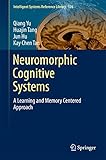Neuromorphic Cognitive Systems [electronic resource] : A Learning and Memory Centered Approach / by Qiang Yu, Huajin Tang, Jun Hu, Kay Tan Chen.
By: Yu, Qiang [author.] .
.
Contributor(s): Tang, Huajin [author.] | Hu, Jun [author.]
| Hu, Jun [author.] | Tan Chen, Kay [author.]
| Tan Chen, Kay [author.] | SpringerLink (Online service)
| SpringerLink (Online service) .
.
Material type:  BookSeries: Intelligent Systems Reference Library: 126Publisher: Cham : Springer International Publishing : Imprint: Springer, 2017Edition: 1st ed. 2017.Description: XIV, 172 p. online resource.Content type: text Media type: computer Carrier type: online resourceISBN: 9783319553108.Subject(s): Computational intelligence
BookSeries: Intelligent Systems Reference Library: 126Publisher: Cham : Springer International Publishing : Imprint: Springer, 2017Edition: 1st ed. 2017.Description: XIV, 172 p. online resource.Content type: text Media type: computer Carrier type: online resourceISBN: 9783319553108.Subject(s): Computational intelligenceIntroduction -- Rapid Feedforward Computation by Temporal Encoding and Learning with Spiking Neurons -- A Spike-Timing Based Integrated Model for Pattern Recognition -- Precise-Spike-Driven Synaptic Plasticity for Hetero Association of Spatiotemporal Spike Patterns -- A Spiking Neural Network System for Robust Sequence Recognition -- Temporal Learning in Multilayer Spiking Neural Networks Through Construction of Causal Connections -- A Hierarchically Organized Memory Model with Temporal Population Coding -- Spiking Neuron Based Cognitive Memory Model.
This book presents neuromorphic cognitive systems from a learning and memory-centered perspective. It illustrates how to build a system network of neurons to perform spike-based information processing, computing, and high-level cognitive tasks. It is beneficial to a wide spectrum of readers, including undergraduate and postgraduate students and researchers who are interested in neuromorphic computing and neuromorphic engineering, as well as engineers and professionals in industry who are involved in the design and applications of neuromorphic cognitive systems, neuromorphic sensors and processors, and cognitive robotics. The book formulates a systematic framework, from the basic mathematical and computational methods in spike-based neural encoding, learning in both single and multi-layered networks, to a near cognitive level composed of memory and cognition. Since the mechanisms for integrating spiking neurons integrate to formulate cognitive functions as in the brain are little understood, studies of neuromorphic cognitive systems are urgently needed. The topics covered in this book range from the neuronal level to the system level. In the neuronal level, synaptic adaptation plays an important role in learning patterns. In order to perform higher-level cognitive functions such as recognition and memory, spiking neurons with learning abilities are consistently integrated, building a system with encoding, learning and memory functionalities. The book describes these aspects in detail.


There are no comments for this item.